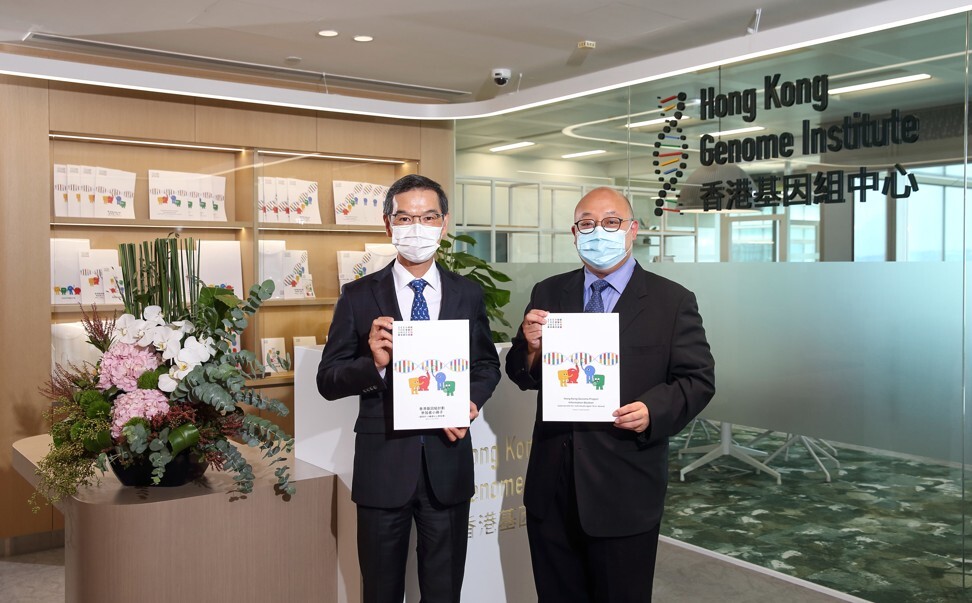
Genome sequencing cracked the code of Hong Kong schoolgirl’s illness, can solve other diagnosis puzzles
- Anna Chu, 10, went years without knowing the reason for her eyesight problems before genome testing revealed she had a rare condition called Alström syndrome
- Scientists behind the Hong Kong Genome Project meet the press for the first time, appealing for patients with undiagnosed disorders to come forward
Anna Chu, 10, has struggled with her eyesight since she was born, without even knowing what was causing the problem until three years ago.
After years of failed diagnosis, genome testing eventually discovered a DNA defect she shared with other patients whose details were logged on a global database – revealing her to have Alström syndrome, a condition afflicting only 900 people worldwide.
While the syndrome, according to medical precedent, could completely deprive Anna of her vision by the age of 16, the diagnosis came as a relief for her family, who hope the onset of symptoms can be delayed through treatment.
Hong Kong lays out blueprint for future of genomic medicine
Her case was held up for inspiration on Wednesday as the leaders of a Hong Kong government-backed project – who were meeting the press for the first time since the scheme’s launch – appealed for patients with undiagnosed conditions to come forward.
Anna’s doctor Brian Chung Hon-yin is now the chief scientific officer of the Hong Kong Genome Institute, an organisation set up in May last year and based in Sha Tin’s Science Park which is hoping to shorten diagnosis periods for patients.
It will recruit 2,000 patients with undiagnosed disorders or hereditary cancer in the pilot phase and 18,000 more with those or other diseases that could benefit from whole genome sequencing in the second phase. Together with their family members, they will contribute some 40,000 to 50,000 DNA samples to the database.
Chung on Wednesday described Anna’s case as the culmination of a “diagnostic odyssey”. Her father Jack Chu said it was “like drifting in the dark ocean with no direction”. “When we received the genomic result, it was like the shore was finally in sight.”
Anna’s disease causes progressive loss to vision and hearing, and is linked with problems such as diabetes, obesity and even issues with heart muscles.
Delays to diagnosis – the longest known to doctors taking 20 years – and treatment, especially after puberty when growth hormones have exacerbated the symptoms, could make matters worse.
“We felt more at ease as the result gave us a sense of direction,” Jack Chu said, adding he was hopeful that personalised treatment and interventions, including four days of exercise per week, could delay the onset of symptoms for his daughter.
He said “every second counts”, noting that delayed treatment had in one case left a patient with an S-shaped spine and damage to their internal organs.

Speaking to the press on Wednesday, Dr Chung and the group’s CEO Dr Lo Su-vui said the genome analysis project would not only help “shorten the diagnostic journey” and support the design of personalised treatment for those participants, but also create and enrich a local DNA bank that could foster research in this modern area of medical science and improve the prospects of future patients.
Chung revealed that a soft launch in July had recruited 22 people from nine families with long troubled histories of undiagnosed diseases, comprising both adults and children from Queen Mary and Hong Kong Children’s Hospitals.
That first batch of participants included a 15-year-old girl whose kidneys were so weak that she had to receive a transplant, Chung said, adding such an occurrence was very rare for someone her age. She was also suffering from other debilitating symptoms.
DNA project in Hong Kong 'could unlock treatments' for rare diseases
The institute had hit the ground running, Dr Lo said, revealing that a preliminary report it commissioned an independent auditor to write had found the group’s privacy protocols to be sound.
Biometric samples and data would never leave the institute nor cross the border to mainland China, Lo pledged, as he said the arrangements in place meant the information would only be given to the team of doctors treating the patient, or in an anonymous form, to scientists whose research was deemed worthy by the institute.
Even then, those researching scientists could not “download or export” data. “It is like a reading library, not a lending library,” Chung said, adding patients could opt out of the scheme any time they wanted and even withdraw their data from the database 10 years later.
Lo said the institute now had more than 40 staff, a team of mostly home-grown experts from local universities, and hoped to increase its workforce to 60 or 70.
